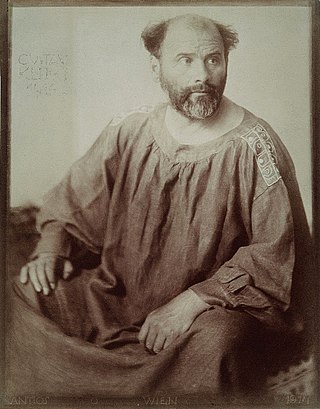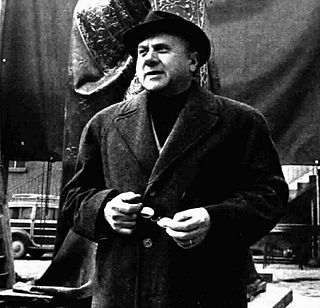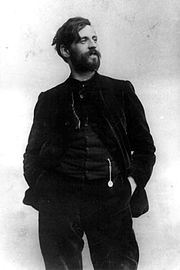
Gustav Klimt was an Austrian symbolist painter and one of the most prominent members of the Vienna Secession movement. Klimt is noted for his paintings, murals, sketches, and other objets d'art. Klimt's primary subject was the female body, and his works are marked by a frank eroticism. Amongst his figurative works, which include allegories and portraits, he painted landscapes. Among the artists of the Vienna Secession, Klimt was the most influenced by Japanese art and its methods.

The Galleria Nazionale d'Arte Moderna e Contemporanea, also known as La Galleria Nazionale, is an art museum in Rome. It was founded in 1883 on the initiative of the then minister Guido Baccelli and is dedicated to modern and contemporary art.
Gianfranco Goberti was an Italian painter.

Ettore Tito was an Italian artist particularly known for his paintings of contemporary life and landscapes in Venice and the surrounding region. He trained at the Accademia di Belle Arti in Venice and from 1894 to 1927 was the Professor of Painting there. Tito exhibited widely and was awarded the Grand Prize in painting at the 1915 Panama–Pacific International Exposition in San Francisco. In 1926 he was made a member of the Royal Academy of Italy. Tito was born in Castellammare di Stabia in the province of Naples and died in Venice, the city which was his home for most of his life.
Antonio Bueno was an Italian painter of Spanish origin, who acquired Italian citizenship in 1970. He was born in Berlin while his journalist father was posted there by the newspaper ABC of Madrid.

Francesco Messina was an Italian sculptor of the 20th century.

Cesare Tallone was an Italian painter.

Leonardo Dudreville was a Venetian-born Italian painter. He was one of the founders of the Nuove Tendenze as well as of Novecento Italiano art movements.
Sergio Zanni is an Italian painter and sculptor. After obtaining the Diploma at the Institute of Arts 'Dosso Dossi' in Ferrara, Italy, he graduated from the Academy of Arts in Bologna. He taught in the Institute of Arts 'Dosso Dossi' until 1995. For his research in sculpturing he utilized backed clay and, successively, lighter material for sculptures of large dimensions.
Roberto Melli (1885–1958) was an Italian painter and sculptor to the Scuola Romana, and active in Ferrara and Rome.

Piergiorgio Colautti is a modern Italian painter and sculptor, who lived and worked in Rome. He is known for his own distinctive style, sometimes labelled "Hyperfuturism", in which figurative elements are enmeshed and submerged by symbols reflecting a cold and modern technological world.
Marina Apollonio is an Italian painter and optical artist. She lives and works in Padua.

Giuseppe Amisani was an Italian portrait painter of the Belle Époque.

Juti Ravenna was an Italian painter.

Boncompagni Ludovisi Decorative Arts Museum, Rome, is the Decorative Arts Museum of the National Gallery of Modern Art of Rome. The Museum is located at Via Boncompagni, 18, near the elegant and historical Via Veneto.
Guglielmo Amedeo Lori (1869–1913) was an Italian painter of landscapes in a Divisionist style.

Palma Bucarelli was an Italian art historian, curator and administrator, mostly known for her tenure as director of the Galleria Nazionale d'Arte Moderna (GNAM) in Rome from 1942 to 1975.

Self-Portrait Aged 71 is an 1862 oil-on-canvas painting by the Italian artist Francesco Hayez. The Uffizi had been requesting a self-portrait from him since 1858 via Andrea Appiani's daughter-in-law Giuseppina Appiani Strigelli and it finally arrived in 1863. It is still in the Uffizi's Vasari Corridor.
Michele Sambin is an Italian theatre director and artist.














